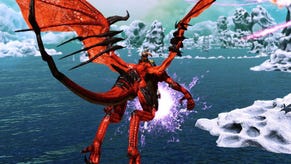Project Draco
Dragoon on.
Riding these beasts, it turns out, requires the kind of loose, broad movements that are perfect for Kinect. Moving your centre of gravity directs the dragon around the screen - and in having you play the rider rather than the dragon, Project Draco's got the perfect excuse for any lag that may occur.
For the business of targeting and shooting, Project Draco's control scheme is as familiar as many of its other elements, although this time the inspiration's a little more contemporary. Your right hand controls an onscreen reticule, your left a slottable skill, and raising both hands in the air fires off a special move that's unlocked by collecting blue orbs from fallen foes. Essentially, it's the same 'grasp and splay' lock-on mechanic that Child of Eden, another Kinect shooter of a similar mindset, recently introduced.
It's another area that Futasagi's disarmingly happy to discuss. "It's unfair to say, 'Do you like shooters? Well, you're going to have to learn a completely different control scheme now,'" he says, with a logic that can't be faulted but is sadly so often absent.
"Child of Eden came out first, so a lot people played that game - and I thought it would be a bad idea if people who played that game are presented with a completely different control scheme. They might get confused.
"I like the Child of Eden control scheme, and I think there's nothing wrong with it. Since we have conceptual similarities, we came up with a similar scheme and we decided not to change it. It's like how Super Mario did it - A button is jump, and every game that followed Mario did the same thing because you don't want to confuse the player."
Indeed, there's a pleasing symmetry to how both Child of Eden and Project Draco are at the frontline of Kinect's core offerings, given the entwined history of the studios behind both games. Team Andromeda, the Panzer Dragoon team, went on to become United Game Artists, who then created Rez - the spiritual predecessor to Child of Eden.
Project Draco is choosing to differentiate itself in other ways. Beneath the shooting there's an RPG backbone that, in a superficial manner, recalls Panzer Dragoon Saga. Between each level you return to a base camp where your dragon can be fed and nurtured with food that's rewarded at a mission's end. Weapons, too, can be levelled up, and there are plenty to grind through, with 150 different flavours available.
Choosing the right weapons is a skill in itself, with some challenges tailor-made to specific loadouts. It lends the game a strategic edge that, Futasagi says, is essential to making a compelling Kinect shooter.
"It's hard to make a high-difficulty game on Kinect," he admits. "If you go over the threshold it becomes impossible and just unfair. On the game pad it's scalable, and you can do a lot of things with difficulty. When you're doing Kinect, if it's too difficult it's impossible and if it's too easy you're falling asleep."
"So that's why we added the strategic layer of being able to choose the right skill for the mission. If you choose the right skill it's easy, but if you choose the wrong skill it gets more difficult. That way we scale it so it's not tied to the control scheme."
As a Kinect-exclusive game, Project Draco is smart as well as compelling, a game that's as aware of the controller's limitations as it is of its potential. The only disappointment comes when it's revealed that this will be a Kinect-exclusive experience, with no option to play with a controller. But that's a slight gripe that's balanced out by how in tune Project Draco is with Kinect, and how overdue a return is to Futasagi's mystical world.









